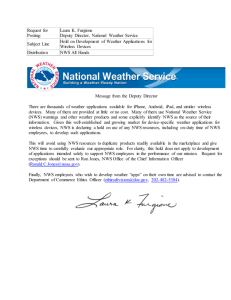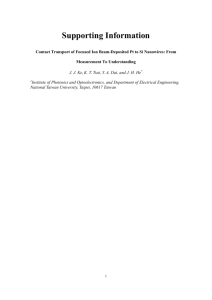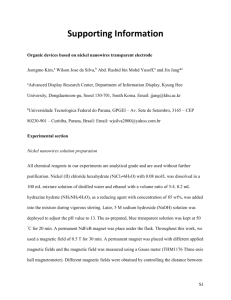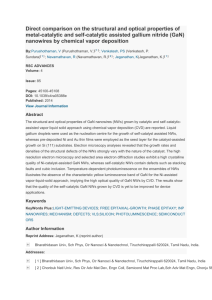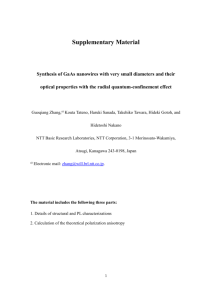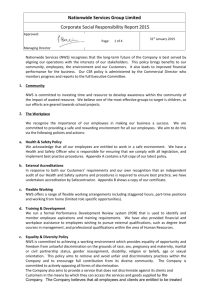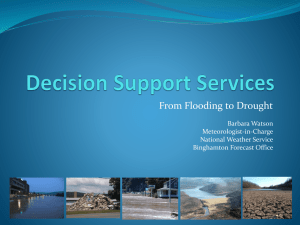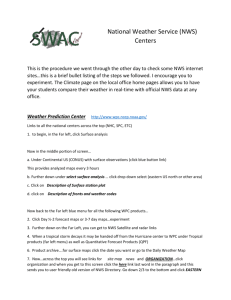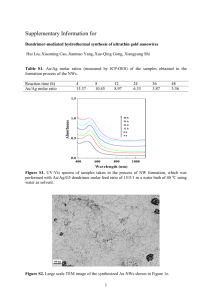Missions, Objectives and Logic Models
advertisement
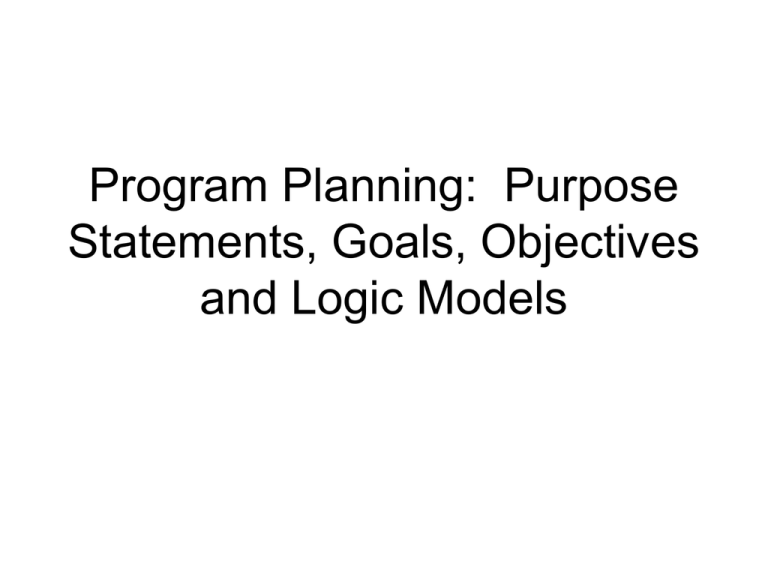
Program Planning: Purpose Statements, Goals, Objectives and Logic Models Purpose Statements Can be used for: Mission statements Program Description As a first step in the development of Performance Measures Purpose Statement Template The purpose of the ________________________ (name of service, program or line of business) is to provide (or produce)______________________ (service or product -what) for _______________________________________ (customer - who ) so that____________________________________ (RESULT / benefit - why) Program Purpose Statement The purpose of the Nutrition Public Health Practice Program is to provide planning, coordination, demonstration and policy development assistance to communities. So that they can develop, implement, and evaluate programs and policies to promote nutrition and physical fitness behavior change. Goals Goals: • Identify & clarify what you want to do or achieve • Define what needs to be accomplished without getting bogged down in issues of measurement and timing • Are described with an action verb & a noun phrase Healthy People 2020 Goals 1. Attain high-quality, longer lives free of preventable disease, disability, injury, and premature death. 2. Achieve health equity, eliminate disparities, and improve the health of all groups. 3. Create social and physical environments that promote good health for all. 4. Promote quality of life, healthy development, and healthy behaviors across all life stages. Objectives Many Kinds of Objectives • • • • Learning Process Outcome Others Program Planning Objectives • Outcome Objective: a statement of the amount of change expected for a specified population within a given time frame. • Process Objective: a statement that measures the amount of change expected in the performance and utilization of interventions that impact on the outcome. Outcome Objectives Are…... • Long term • Realistic • Measurable: – levels of mortality, morbidity, disability – levels of health conditions – behavioral measures Examples of Outcome Objectives & Measures from Healthy People 2020 Nutrition & Weight Status Healthier Food Access NWS–1 State nutrition standards for child care NWS–2 Nutritious foods and beverages offered outside of school meals NWS–3 State-level incentive policies for food retail NWD–4 Retail access to foods recommended by Dietary Guidelines for Americans Health Care and Worksite Settings NWS–5 Primary care physicians who measure patients’ body mass index (BMI) NWS–6 Physician office visits with nutrition or weight counseling or education NWS–7 Worksite nutrition and weight management classes and counseling Weight Status NWS–8 Healthy weight in adults NWS–9 Obesity in adults NWS–10 Obesity in children and adolescents NWS–11 Inappropriate weight gain Food Insecurity NWS–12 Food insecurity among children NWS–13 Food insecurity among households Food and Nutrient Consumption NWS–14 Fruit intake NWS–15 Vegetable intake NWS–16 Whole grain intake NWS–17 Solid fat and added sugar intake NWS–18 Saturated fat intake NWS–19 Sodium intake NWS–20 Calcium intake Iron Deficiency NWS–21 Iron deficiency in young children and in females of childbearing age NWS–22 Iron deficiency in pregnant females Nutrition Related Objectives in Other Categories Maternal, Infant & Child Health Low birth weight (LBW) & very low birth weight (VLBW) Recommended weight gain in pregnancy Preconceptual folic acid intake & folate status Healthy weight prior to pregnancy Breastfeeding Diabetes Glycemic control Lipid control Blood pressure control Prediabetes treatment Physical activity Schools & Child Care Screen time Heart Disease & Stroke Cholesterol levels Treatment of pre hypertension (BMI, sodium, sat fat) Education & communityBased Programs “Unhealthy dietary patterns” addressed in: Head Start, schools, colleges, community-based organizations Eliminate Very Low Food Security Among Children Baseline Target 1.3 percent of households with children had very low food security among children in 2008 0.2 percent Target Setting Method Consistent with the Department of Agriculture’s policy to eliminate childhood hunger by 2015 Data Source Food Security Supplement to the Current Population Survey, U.S. Department of Commerce, Bureau of the Census Process Objectives Are…….. • • • • Short-term Realistic Measurable Related to outcome measures – there may be several process measures for one outcome measure Example of Process Objectives • By December 2002, 40 female students who seek services at the teen health center will receive brief counseling interventions from the clinic nurse about use of folic acid supplements to prevent NTD. When The time (month, year) by or during which the intervention should be accomplished or health status should change What The targeted health problem/behavior to be changed or the targeted intervention to be accomplished. Whom The target population who will benefit Where The area in which the target population is located Who Staff or agency responsible How much The amount of the intervention to be utilized, performed, or accomplished or the quantity of change in a health problem. Logic Models What is a Logic Model? • • • • Tool for program planning and evaluation Picture of a program Graphic representation of “theory of action” Relationship between what we put in (inputs), what we do (outputs), and what results (outcomes) • Logical chain of if-then relationships Why Develop Logic Models? • Visual displays are effective learning instruments for all involved • Shows why planned actions are likely to lead to desired results • Assures that process is not overlooked in evaluation • Enhances ability to use on-going evaluation for mid-course corrections Logic Models Promote a Shared Vision • Provide common language and reference point for all involved • Fundamental purpose is clear • Role of actions are clear • Desired results at each step are clear Step 1: Determine Scope • Can be good overview of whole program • Smaller pieces of program can be shown in more detail Step 2: Identify Components • Inputs: what you do to make the program possible, resources applied • Outputs: what happens during the implementation • Outcomes: the direct result of your program activities Step 3: Draft Model • • • • • • • Should be single page “Landscape” layout Write left to right, not top to bottom Use thin lines, don’t alter thickness Avoid abbreviations Use simple font, avoid italics Show “if - then” visually Step 4: Develop Evaluation Indicators • Process: measure activities – ex: numbers of trainings, meetings, technical assistance provided • Outcome: measure short, medium, and long term outcomes – ex: increased understandings, behavior change, health outcomes Good Indicators Are….. • • • • Relevant Measurable Available or collectable Acceptable to participants, planners, funders and other stakeholders Framing Evaluation Questions http://www.wkkf.org/knowledge-center/resources/2010/Logic-Model-Development-Guide.aspx Step 5: Revisit the Model Frequently • Lay indicator data directly onto model • Determine what’s working and what isn’t • Modify model if change theory isn’t working • Modify activities if unable to complete as planned Group Work 1. Use the purpose statement template to describe the purpose of your project 2. Develop a logic model for your project 3. Develop at least one process objective and indicate where it fits on the logic model 4. Develop at least one outcome objective and indicate where it fits on the logic model
